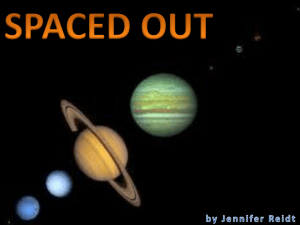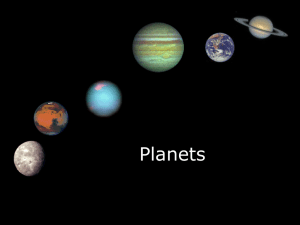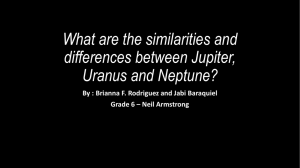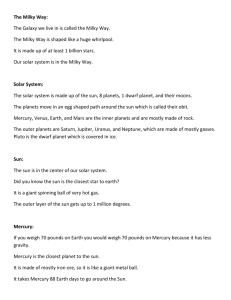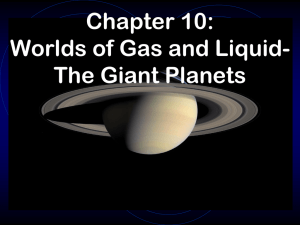1. Be able to chose between characteristics of Jovian and Terrestrial
advertisement
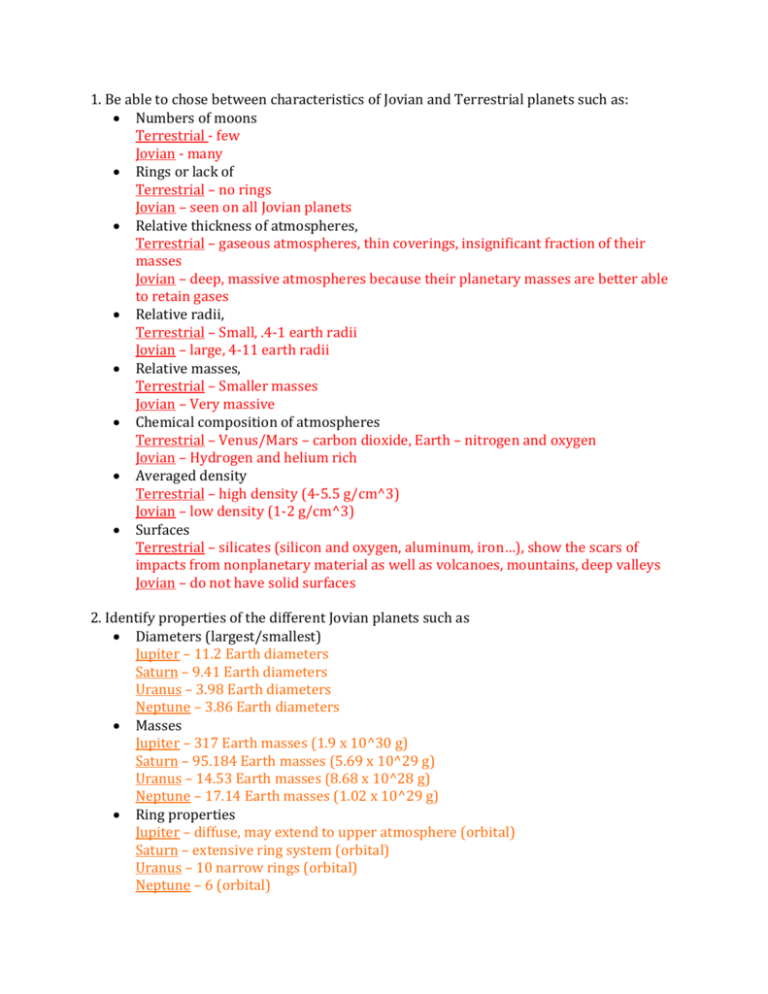
1. Be able to chose between characteristics of Jovian and Terrestrial planets such as: Numbers of moons Terrestrial - few Jovian - many Rings or lack of Terrestrial – no rings Jovian – seen on all Jovian planets Relative thickness of atmospheres, Terrestrial – gaseous atmospheres, thin coverings, insignificant fraction of their masses Jovian – deep, massive atmospheres because their planetary masses are better able to retain gases Relative radii, Terrestrial – Small, .4-1 earth radii Jovian – large, 4-11 earth radii Relative masses, Terrestrial – Smaller masses Jovian – Very massive Chemical composition of atmospheres Terrestrial – Venus/Mars – carbon dioxide, Earth – nitrogen and oxygen Jovian – Hydrogen and helium rich Averaged density Terrestrial – high density (4-5.5 g/cm^3) Jovian – low density (1-2 g/cm^3) Surfaces Terrestrial – silicates (silicon and oxygen, aluminum, iron…), show the scars of impacts from nonplanetary material as well as volcanoes, mountains, deep valleys Jovian – do not have solid surfaces 2. Identify properties of the different Jovian planets such as Diameters (largest/smallest) Jupiter – 11.2 Earth diameters Saturn – 9.41 Earth diameters Uranus – 3.98 Earth diameters Neptune – 3.86 Earth diameters Masses Jupiter – 317 Earth masses (1.9 x 10^30 g) Saturn – 95.184 Earth masses (5.69 x 10^29 g) Uranus – 14.53 Earth masses (8.68 x 10^28 g) Neptune – 17.14 Earth masses (1.02 x 10^29 g) Ring properties Jupiter – diffuse, may extend to upper atmosphere (orbital) Saturn – extensive ring system (orbital) Uranus – 10 narrow rings (orbital) Neptune – 6 (orbital) Inclination of rotational axes Jupiter – 3.1 degrees Saturn – 26.7 degrees Uranus – 97.92 degrees Neptune – 28.8 degrees Moon systems Jupiter – over 60 moons Saturn – over 60 moons Uranus – 27 Neptune -13 Relative distance from the Sun Jupiter – 5.2 AU Saturn – 9.54 AU Uranus – 19.2 AU Neptune – 30.1 AU Average densities Jupiter – 1.3 g/cm^3 Saturn – 0.69 g/cm^3 Uranus – 1.32 g/cm^3 Neptune – 1.64 g/cm^3 Orbital periods Jupiter – 11.86 years Saturn – 29.45 years Uranus – 84.02 years Neptune – 164.79 years 3. Identify properties and processes of the Terrestrial planets such as Intensity of the greenhouse effect Mercury – no greenhouse effect due to a lack of an atmosphere Venus – warms by hundreds of degrees because its atmosphere is 100 times denser than Earth Earth – warms the Earth by about 40 Kelvin or 70 degrees Fahrenheit Mars – small greenhouse effect (7 Kelvin warming because its atmosphere is about 150 times less than Earth’s) Did it rain or not Mercury – Venus – Earth – Yes Mars – Chemical composition of clouds and atmospheres Mercury – Atmosphere – none, Clouds - none Venus – Atmosphere – 96.5% CO2, 3.5% N2, Clouds – Sulfuric Acid droplets, complete coverage Earth – Atmosphere – 78% N2, 21% O2, Clouds – Water vapor, partial coverage Mars – Atmosphere – 95.3% CO2, 2.7% N2, Clouds – Carbon dioxide ice, water vapor dust, slight to complete coverage Evidence of water Mercury – Venus – Water vapor, temperatures were so high that it was unable to condense into liquid water Earth – Yes Mars – Yes Atmospheric temperatures Mercury – Venus – Earth – Mars – Relative diameters Mercury – 4,878 km (.382 Earth diameters) Venus – 12,104 km (.949 Earth diameters) Earth – 12, 756 km Mars – 6,794 km (.53 Earth diameters) 5. After those matching questions be able to distinguish between Hypotheses A preliminary explanation for a phenomenon that may or may not be supported by further observations or experiments, a summary of the available data that helps researchers visualize what is going on, a statement made to explain a fact Predictions of hypotheses What you think the hypothesis will find Verifications of a prediction A discovery supporting the hypothesis Observations of nature A general fact about something seen in real life
